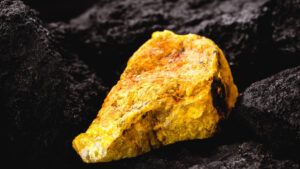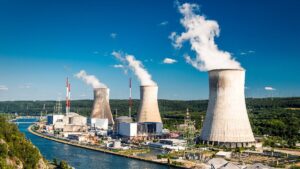Uranium miners still have eyes on sky high price as yellowcake deficit emerges

Pic: Marc Dufresne/iStock via Getty Images
- Uranium developers and explorers continue to tip prices rising to new records in the current bull run
- Even without the development of small modular reactors, Tribeca’s Guy Keller told a conference in Singapore supply will be outstripped by demand into the 2030s
- NexGen Energy, Elevate Uranium and Global Uranium and Enrichment all bullish on their prospects of riding the nuclear wave into production
Despite a recent dip which stalled an almost year-long run in uranium prices, miners are putting their mouth where their money is, tipping spot prices will hit a new record in the coming bull run.
Following Tribeca Nuclear Energy Opportunities Strategy portfolio manager Guy Keller’s call that uranium should hit US$175/lb, leaders from three ASX listed companies have punted on sky-high prices to return for the first time since the mid-2000s ahead of an expanding global deficit.
Taking part in a panel at the Future Commodities Forum hosted by Tribeca and Vertical Events backed Resource Connect Asia in Singapore yesterday, Elevate Uranium’s (ASX:EL8) MD Murray Hill tipped US$150/lb, Global Uranium and Enrichment’s (ASX:GUE) Andrew Ferrier tipped US$150/lb ‘on the way to US$200/lb’, while NexGen Energy’s (ASX:NXG) Stacey Golokin tipped US$175/lb (notably more muted than her US$300/lb punt at the RIU Resurgence conference last year).
Moderating the panel, Keller said even without small modular reactors being factored in a major deficit was on the cards against the backdrop of the largest nuclear reactor build since the 1970s.
“I don’t need small modular reactors or advanced nuclear in my supply-demand models to see a deficit out past 2030,” he said.
NexGen’s Arrow deposit in Canada’s legendary Athabasca Basin is on track to be the largest single uranium mine in the world once it’s in operation, peaking at 29Mlbpa during its decade-long mine life.
But Keller says even that won’t fill the gap.
“Post Fukushima, Japan and Germany turned off their nuclear power, the rest of the world continued to use nuclear electricity — 420 reactors around the world. On the flip side at the mining end of the equation, the capital’s dried up overnight, and we’ve had more than a decade of of underinvestment,” he said.
“We’re now in the biggest reactor build program we’ve seen in decades with 62 reactors being built.
“When NexGen brings that deposit to market, the pounds coming out of that deposit will only fulfil the 62 reactors being built now, so to put that in perspective, we’ve got a 50 to 60 million pound deficit already.”
Nuclear growing in acceptance
Nuclear power continues to be outlawed in many places around the world, including Australia where nuclear power and uranium mining have sat on the margins of the political agenda for decades.
But, responsible for around 10% of the world’s electricity supply and — according to Keller — 30-40% of its decarbonisation burden, it is growing in acceptance against the backdrop of the energy transition.
“It’s a bright nuclear future, particularly because more governments and industries are recognising nuclear for the science rather than the false ideologies perpetrated (sic) in the past,” Golokin said.
“We saw a pretty remarkable thing happen last year at the COP28 event in Dubai, where over 22 countries signed the declaration to triple nuclear capacity by 2050. I believe that number has now grown to 28 but it was the biggest endorsement yet of the role that nuclear energy will play in the transition away from fossil fuels.
“And that has also highlighted to governments and industries that there needs to be strong diversification of Western supply as we’ve grown far too reliant on Eastern sources of supply.”
In Namibia, where Elevate owns the shallow 48Mlb Koppies deposit, Hill says the prospects to deliver new projects as prices rise is clear.
“We just had two mining licenses permitted in December for our peers, three uranium projects developed in the last 18 years. So there’s history of it,” he said.
“It’s the only country in the world with a dedicated uranium association, a great conduit between explorers, producers, developers and government. We have access to the government minister. We have a direct line to the mining commissioner.
“It’s a good jurisdiction and … during the last sort of low cycle … the Athabasca basin went into care and maintenance. Yes, they’ve got very high grades and you could argue they preserve their high grades, but the longest continuously running uranium mine in the world is the Rossing uranium mine, commissioned in 1976 in Namibia, 48 years of continuous operation.
“That’s two generations of people familiar with uranium mining, less woke — I know you like that word — over there. And certainly there’s a history of uranium so it’s not a real obstacle for us.”
The opportunity of SMR
SMRs remain a great white hope for the nuclear sector, which wants to deliver plants with shorter lead times to production which can be rolled out in jurisdictions that have typically been less than keen to embrace nuclear power.
The technology suite was dealt a blow last year when NuScale pulled plans to develop the world’s first commercial operation in Idaho after prices spiralled and customer subscriptions fell off.
But many countries and companies are still working to bring the dream to reality.
Importantly, SMRs require higher grades of enrichment than other plants, something that could benefit GUE, which owns both ISR style mines in the United States and a stake in Ubaryon, a private Australian enrichment technologist.
The United States Government is ramping up funding for domestic enrichment suppliers, given that step of the supply chain is dominated by Russia.
“They’re fundamental, especially when you start talking about small modular reactors. In traditional enrichment done through centrifuges it enriches the U-235 to about 3-5% and that’s what goes into conventional big nuclear power plants,” GUE’s Ferrier said.
“Small modular reactors, in most of the examples, require enriched uranium material to that 19% level, that obviously requires a lot more enrichment.”
He said Ubaryon’s chemical enrichment technology could potentially be plugged into plant front ends to help upgrade their material.
“There’s going to have to be a lot of money spent on a lot of innovation (in enrichment),” Ferrier said.
Elevate Uranium (ASX:EL8), Global Uranium and Enrichment (ASX:GUE) and NexGen Energy (ASX:NXG) share prices today

UNLOCK INSIGHTS
Discover the untold stories of emerging ASX stocks.
Daily news and expert analysis, it's free to subscribe.
By proceeding, you confirm you understand that we handle personal information in accordance with our Privacy Policy.








